Act4Mail Manual
Act4Mail is an Outlook integration for Act! Cloud users for both 32 & 64-bit versions of MS Office.
Act4Mail Features
SUPERFAST HISTORY RECORDING
Send an email from Outlook, and it will be automatically attached to the matching record in Act! within a second. Act4outlook supports this feature even with Act! closed, and Act4mail doesn't even require Act! to be installed.
COPY CONTACTS TO ACT!
Send Outlook contacts to Act! by simply right-clicking one or more contacts from your address book, and select "Send to Act!". Perfect when contacts are added to Outlook from sources like business card scanners or vcards.
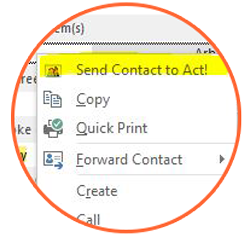
COPY TASKS TO ACT!
Send one or more tasks to Act! from your Outlook To-Do list that you create from either Outlook or your mobile device. IOS users can type countless reminders into their mobile devices, and then send them all to Act! with a couple of clicks of their mouse.
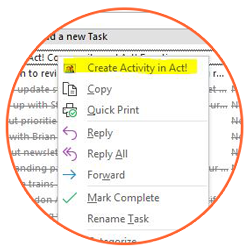
Mail Merging
Act4mail now includes MailMerge4act for robust mail merge functionality to both print & Email. Our powerful design tools and deliverability features allow you to create beautiful templates, and then merge them into personalized emails that bypass Outlook for greater reliability & speed.
INCOMING EMAIL HISTORY RECORDING
Act4Outlook can automatically record and link all incoming messages to the Act database as long as a Contact with the sender's email address is found in the database. Users can also enter one or more domain names to ignore so that any emails sent from those domains are not attached to the database.
LINK TO ACT!
Link your email to additional Contacts, Companies, Groups, or Opportunities on the fly, so the History can be attached to more than just the email recipient.
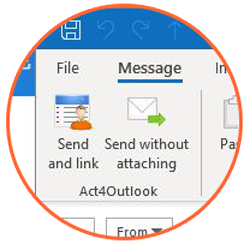
COPY ACTIVITIES TO & FROM ACT!
Keep your Act! & Outlook calendars aligned! Send one or more activities to Act! from your Outlook calendar, or conversely, send activities in Act! to Outlook. Perfect for those invites that never make it to Act!, or appointments you create in one calendar, but not the other. Handy when using Siri, Alexa, or Google Assistant to create appointments, that can easily be transferred to Act!.
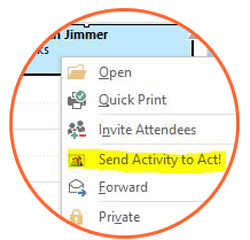
REDUCE CALENDAR DUPES
Act4Outlook reduces duplication by keeping track of previously imported activities. If an activity is updated in Outlook with new data, simply re-send the activity to Act which will update the previously imported Act activity.
COMPARISON BETWEEN ACT4OUTLOOK AND ACT4MAIL
Please check out the Keystroke product page to review comparison between Act4Outlook and Act4Mail
Act4Outlook Installation
- Please note that the latest Act! Web API (version 1.0.409.0 or higher) must be installed on a server which has direct access to the Act! database before you attempt to use Act4Mail on your local desktop. You can download the latest API from Act website at www.act.com/downloads.
If your Act database is hosted with a Act Hosting provider, they can provide you with this URL. If your main Act! database is hosted locally, your Act! Administrator can provide this address. The Act Web API URL is usually in the format https://yourserverhostname.com/act.web.api Note that HTTPS is required for Act! Web API to function.
- The User that will be accessing Act4Mail must also be given the Web API Access permission in Act! Please click Tools > Manage Users in Act, and verify that this permission has been granted to the user otherwise they will not be able to log in to the database.
- If you do not posses an SSL certificate in order to enable HTTPS, you may use Act! Connect Link instead. More instructions can be found here
- Download the Act4Mail setup file to your desktop or download directory. The location has to be easily accessible to you.
- Close any open instances of Outlook.
- If installing on a standalone desktop PC or server, simply double-click on the Act4Mail setup file to initiate the installation process. If you are installing Act4Mail on a RDS/Terminal server, please set the server in install mode prior to running the setup file. More info can be found here.
- Once installed, the Act4WorkUpdater will be launched automatically. It is highly recommended to install any available updates.
Act4Outlook Configuration
- After completing the installation, launch Outlook. Once it is loaded, click on File from the top pull down menu, and then Account Settings. You'll be prompted to click on Account Settings again before the settings screen displays.
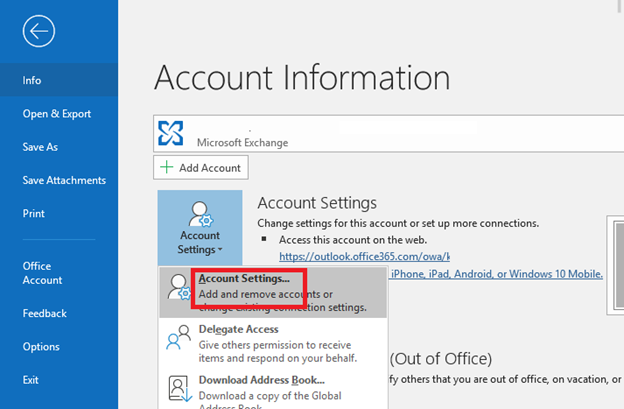
- Click on the Address Books tab on the furthest tab to the right, and you should see Outlook Address Book, and Act! Address Book. Select the Act! Address Book and then click on Remove just above it. Once removed, click on Close, and then restart Outlook. If the Act! Address Book is not visible in the list, please proceed with the steps below.
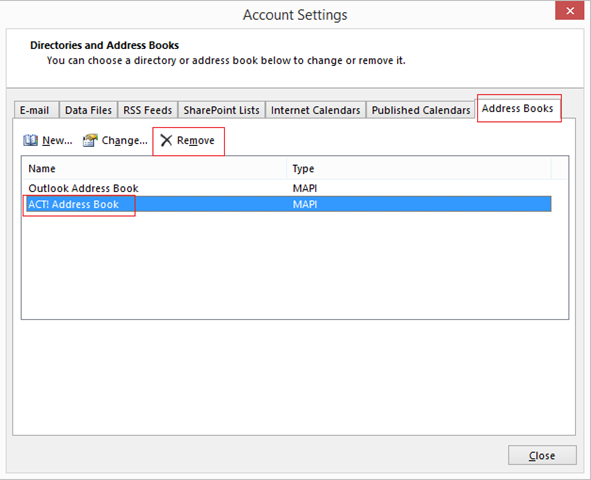
*Note: Starting from Act version 20 and higher, it may also be necessary to disable the native Act! integration addin in Outlook to prevent duplicate histories from being recorded. To do this, click File > Options > Addins, and click the Go button at the bottom. In the list, find and uncheck the Act.Office.Outlook.Addin and click OK.
- Once Outlook has restarted, you should be safe begin the configuration of your Act4outlook. It's important to note all the configuration settings for Act4outlook can be found in Outlook, not Act!.
- Within Outlook on the upper right portion of the toolbar, look for Act4Outlook Settings.
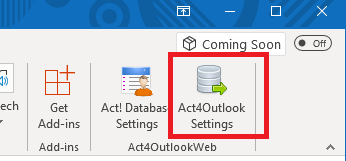
- Click on this and enter your Act For Web and Act4Outlook connection details which includes the server URL, database name, Act! User name, and Act! Password. Click Login to verify that these settings are correct.
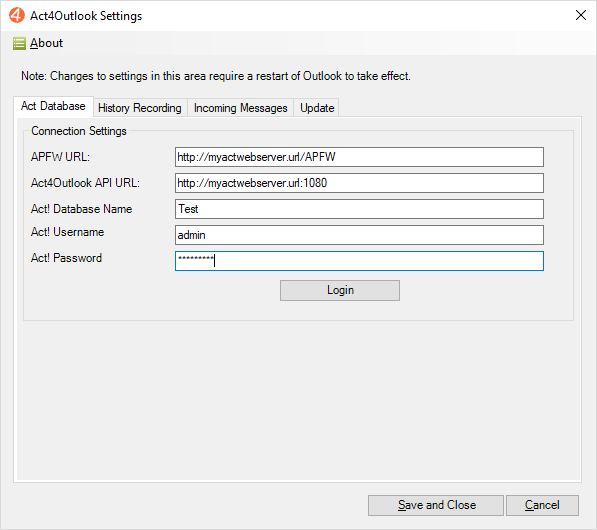
- Click the History Recording tab, and select a history type for the histories that will be recorded to Act!. The Email subject, and body option is recommended if you do not have a preference. If you would like to record emails sent to other users of the Act! database, enable the Attach emails to Act! database users option. If you do not wish other users to read the histories, enable the Make history private option. By default, Act4Mail will only record messages sent from the machine were Act4Mail is installed. If you send emails from other machines that do not have Act4Outlook or Act installed, such as a laptop or phone, you can also enable the Attach all sent messages even if they are not sent from this machine option. Keep in mind that emails will only be recorded if Outlook is running. This option is recommended for people that are using an IMAP/Exchange based email account.
- If you would like the histories to be automatically linked to the Contact's linked Company and/or Opportunities, enable the corresponding options in the History Linking section.
- If you have multiple email accounts in Outlook and would like to exclude emails sent from certain accounts, select the email account in the Excluded Accounts area.
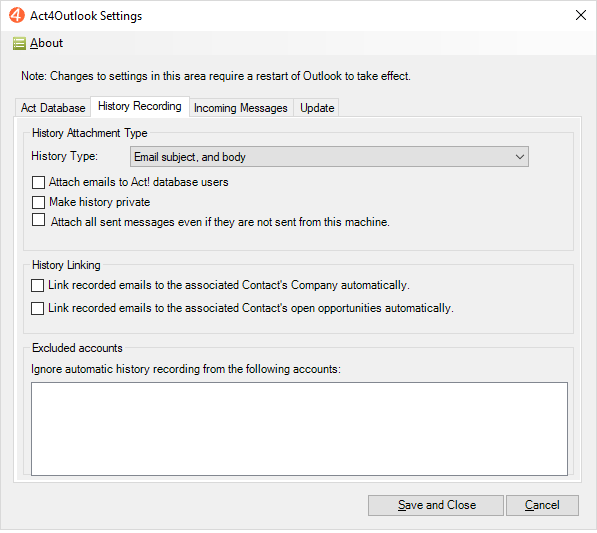
- In the Incoming Messages section, enable the Automatically attach incoming emails option if you would like to record emails sent to you. This could potentially greatly increase the number of histories generated in Act, so it is only recommended if absolutely required. If enabled, you can also set up filters for certain domains which will cause ActOutlook to not record the message if it is sent from that particular domain. Click the + icon on the right hand side of the screen and enter the domain name that you wish to filter out, for example, gmail.com. Doing so will cause any emails sent from a gmail.com address to not be recorded.
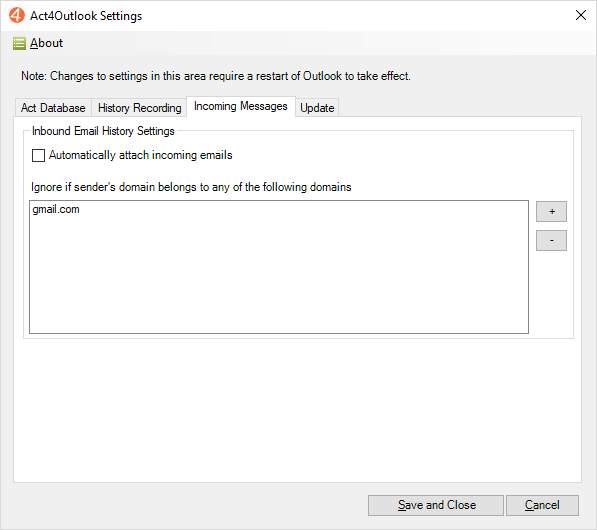
- If you wish to disable automatic check for updates, you can enable that option in the Update tab however we recommend leaving that option disabled so that you are notified when new updates and bug fixes are released.
- The Act! Database Settings button on the Outlook Home toolbar is used to map the Outlook fields to the Act! Fields in your database. By default the Contact Name, and Email address should come pre-configured, but you can enable additional mappings as needed.
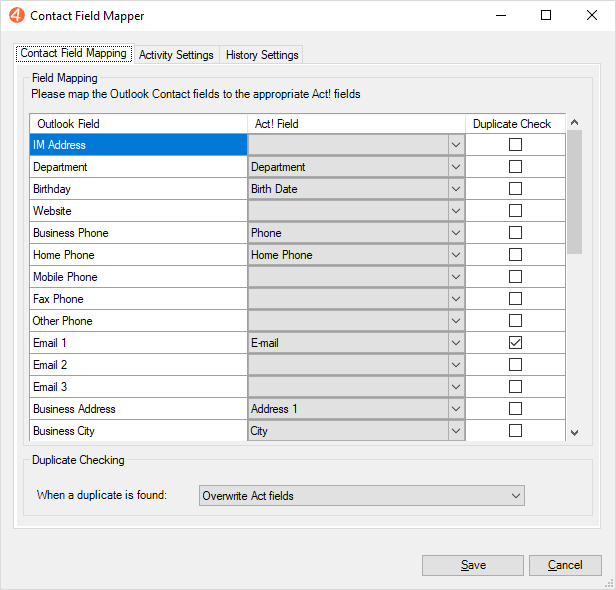
- In the Activity Settings tab, select the Activity Type that will be used when you create activities using Act4Mail. If you would like to automatically show the Create Activity window when you create an activity in Outlook, enable the checkbox below.
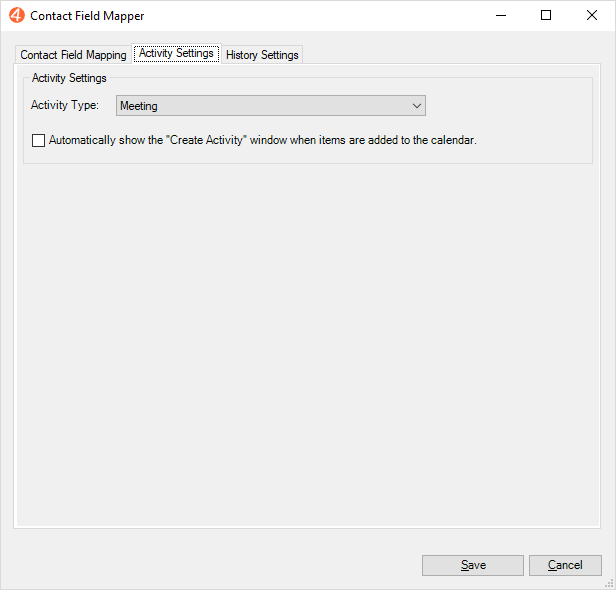
- In the History Settings tab, select the History Type that will be used when recording incoming emails. The default type is Email Auto-Attached.
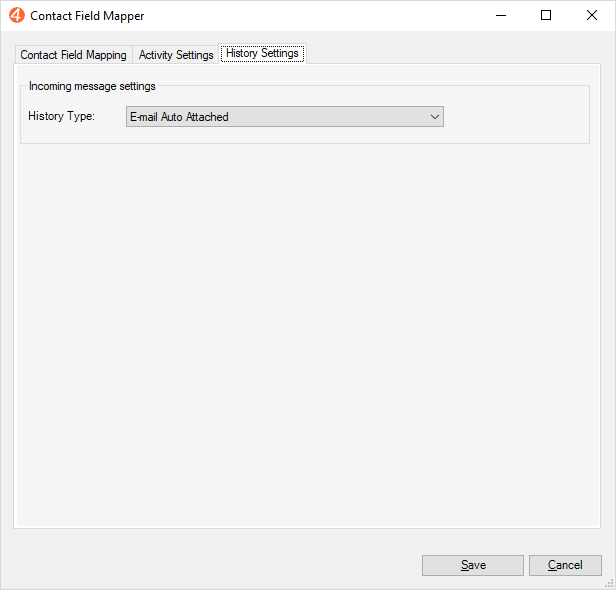
- Click Save to save your settings.
- Once these steps are completed, you are free to start using Act4outlook on your desktop to increase your Act!/Outlook Integration and your efficiency when working with both program.